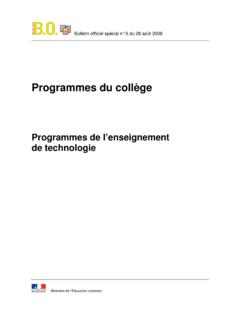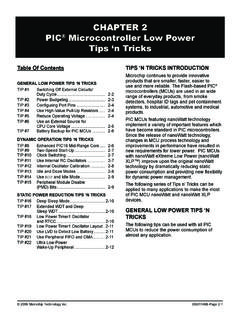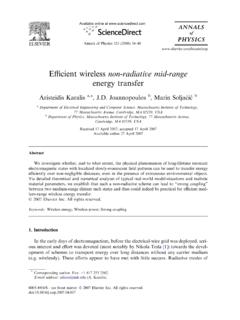Transcription of A Field Guide to Renewable Energy Technologies
1 A Field Guide to Renewable Energy technologiesland art generator initiativesolarwindbiowaterotherRobert Ferry & Elizabeth MonoianThe Land Art Generator Initiative provides a platform for innovative ways of thinking about what Renewable Energy generation looks like and how it relates to the overall fabric of our constructed and natural environments. It calls on interdisciplinary teams to conceive of large scale site-specific artworks that provide Renewable electricity to the city at a utility-scale (equivalent to the demand of hundreds of homes). Once constructed, these public infrastructure artworks will offset thousands of tons of CO2 and provide iconic amenities that will serve to educate and inspire the communities in which they are a part of the Land Art Generator Initiative, we have put together this Field Guide of Renewable Energy generation Technologies as a useful resource for all designers, homeowners, urban planners, students, artists, architects and landscape architects, engineers, and anyone else interested in a clean Energy future.
2 There is a lot more out there than what we see in the everyday. In fact, you will see in this Guide that there are dozens of proven methods of harnessing the power of nature in sustainable ways. Some of the more interesting examples that may be applicable as a medium for public art installations are the organic thin films which are flexible and offer interesting hues and textures, piezoelectric generators that capture vibration Energy , and concentrated photovoltaics, which allow for interesting play with light. But the possibilities are endless, and new designs that can be artistically integrated into residential and commercial projects are coming into the market all the is our hope that this Field Guide will get you thinking creatively about ways to use Technologies in innovative contexts and that a clear understanding of the wealth of possibilities that are out there will help designers to conceive of the most creative net zero Energy constructions.
3 ABOUT THIS GUIDEa Field Guide to Renewable Energy Technologies land art generator initiativesolarwindbiowaterothera Field Guide to Renewable Energy Technologies land art generator initiative1 Solar thermal is any installation in which solar radiation is used to heat a medium such as water or air. Water can be for direct use in the domestic plumbing system of a building and for radiant floor heating (instead of relying on natural gas or grid source electricity that is most likely generated from fossil fuels to heat the water). These systems typically utilize either flat plate or evacuated tube collection systems. Solar heated water can serve as an Energy storage mechanism to create thermal heat lag within occupied space such as with a trombe wall.
4 Other systems that can help heat occupied space rely on air rather than water. The air is circulated through a cavity that is exposed to direct sunlight on the exterior of a building. A very simple example of thermal Energy is a greenhouse where the entire building acts as the solar Energy collection NON-CONCENTRATING solarEVACUATED TUBE SYSTEM Photo provided by Lumen Solar, courtesy of Apricus Solar Hot outputenergy input45% 75% Depending on system type & operating temperatureSolar thermal collectors can be mounted on the roof or the wall of a building, or in another location that has exposure to the combisystems: solar thermal is often used in combination with other Energy -saving techniques such as ground source heat (geosolar systems), and solar thermal cooling (absorption refrigeration).
5 One large installation can be used for district heating of multiple Field Guide to Renewable Energy Technologies land art generator initiative2 The heat that is trapped at the bottom of a saltwater pond can be harnessed to power an organic Rankine cycle turbine or a Stirling engine, both of which convert heat into electricity without steam (does not require temperatures in excess of H2O boiling point). Via the Organic Rankine Cycle (ORC), water is piped to an evaporator coil that heats a low-boiling-point fluid to pressurized vapor, driving a turbine. The vapor then passes to a condenser, where water from the top layer of the pond is used to cool the fluid back into liquid form after which it is then pumped back to the evaporator (with Energy from a PV panel on-site).
6 Because salt water is an excellent thermal heat sink, the solar pond produces electricity 24 hours per day regardless of weather conditions. Efficiency is greater in climates that receive higher average solar POND (SALTWATER)solarA defining characteristic of a highly saline body of water is that it naturally stratifies into three layers of salinity. At the surface is a layer of low salinity and at the bottom is a layer of very high salinity. In between there is an intermediate insulating layer that keeps a heat exchange convention cycle from forming. When exposed to solar radiation, heat is trapped in the bottom of the salt water pond where temperatures can reach nearly 100 C while water at the surface is 30 POND CONVERSIONEFFICIENCY== Energy outputenergy input10%linersalt gradient layerhigh salt content hot brineheat exchanger tubesRankine-cycle electrical generatorlower salt and cooler waterwind protectiona Field Guide to Renewable Energy Technologies land art generator initiative3 The concentrated parabolic trough design is one of the most common types of solar power systems in application for utility-scale electricity generation.
7 It consists of a series of long, highly polished parabolic reflecting surfaces that focus sunlight onto an absorber tube running along the focal point of the parabola. A heat transfer fluid (typically an oil) runs through the tube and is heated to approximately 400 C to provide the thermal Energy required to run a steam parabolic shape of the reflector allows the troughs to be oriented on a north-south axis and track the sun in only one rotational axis from east to west each polished metals are often used as the reflector material since parabolic curved mirrors can be complex to (CSP)PARABOLIC TROUGH solarSEGS POWER PLANT AT KRAMER JUNCTION IN THE MOJAVE DESERT Owned and operated by FPL Energy .
8 Image via of 2010, CSP (concentrated solar power) plants in operation in the USA met the needs of over 350,000 people and displaced the equivalent of million barrels of oil CSP typically requires large tracts of land, but Micro CSP systems can be designed for installation on building outputenergy input25%a Field Guide to Renewable Energy Technologies land art generator initiative4 Linear Fresnel Reflectors (LFR) use long, thin segments of flat mirrors to focus sunlight onto a fixed absorber located at a common focal point of the reflectors. Absorbers in LFR often contain multiple heat transfer to the more common parabolic trough, this single-axis tracking concentrated reflector system heats up a transfer fluid which in turn heats water to run a steam turbine (in the case of LFR, temperatures in the transfer fluid can reach 750 C although 300 C is more common).
9 One advantage of LFR is that the reflector mirrors are flat rather than parabolic in shape, which makes for a simpler mirror manufacturing can be set up to focus sunlight onto a single absorber (LFR) or onto multiple absorbers which is referred to as a Compact Linear Fresnel Reflector (CLFR) system. CLFR design is obtained by alternating the angle of each reflector. This can lead to greater Energy conversion efficiency of the overall (CSP)LINEAR FRESNEL REFLECTOR(LFR OR CLFR)solarKIMBERLINA POWER PLANT IN BAKERSFIELD, CALIFORNIAI mage courtesy of AREVA outputenergy input20%Fresnel geometry allows flat surfaces to act in a way that mimics convex or concave mirror or lens was originally developed by French physicist Augustin-Jean Fresnel for use in a Fresnel reflector, a parabolic mirror is simulated in a segmented or Fresnel arrangement of flat Field Guide to Renewable Energy Technologies land art generator initiative5 THERMALCONCENTRATED (CSP)
10 DISH STIRLING solarThe Stirling Engine is a type of external combustion engine of the reciprocating piston variety. It is named after Robert Stirling, who in 1816 invented the closed-cycle air engine works on the principle that gas expands as its temperature increases. Expansion and contraction cycles will move a piston back and forth within a closed chamber. A magnetic piston moving through an electromagnetic Field becomes a linear alternator, thus producing electric Energy SYSTEMS At the Sandia National Laboratories in Albuquerque, New Mexico. CONVERSIONEFFICIENCY== Energy outputenergy type collectors look sort of like television satellite receivers in their shape. They are parabolic, but unlike a linear parabola that concentrates along an axis, these are dish parabolas that concentrate light onto a single point.





